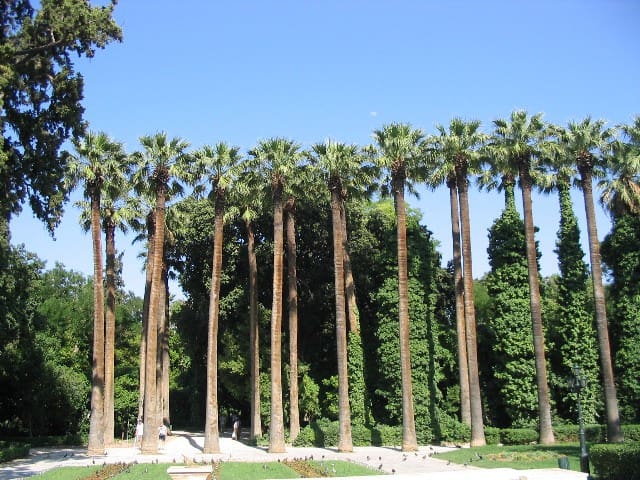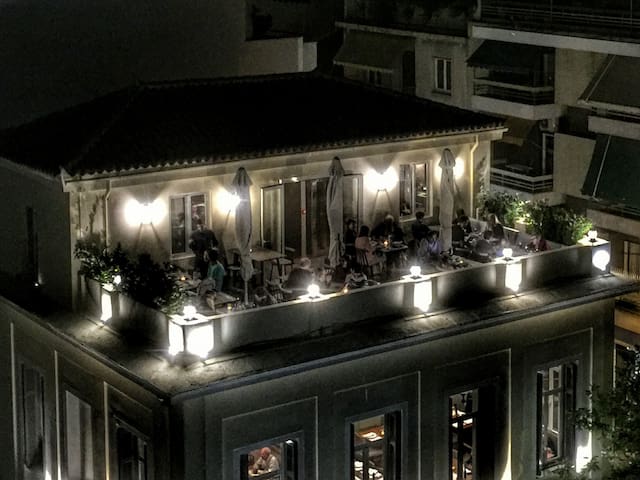Αξιοθέατα
In this section I will present you the most interesting sights of the country that are close to my studio
The Acropolis Museum is an archaeological museum focused on the findings of the archaeological site of the Acropolis of Athens. The museum was built to house every object that has been found on the sacred rock of the Acropolis and its foothills, covering a wide time period from the Mycenaean period to Roman and Early Christian Athens, while at the same time it is located on the Makrygianni archaeological site, a relic of Roman and Early Byzantine Athens.
2190 (рекомендации местных жителей)
Новый музей Акрополя
15 Dionysiou AreopagitouThe Acropolis Museum is an archaeological museum focused on the findings of the archaeological site of the Acropolis of Athens. The museum was built to house every object that has been found on the sacred rock of the Acropolis and its foothills, covering a wide time period from the Mycenaean period to Roman and Early Christian Athens, while at the same time it is located on the Makrygianni archaeological site, a relic of Roman and Early Byzantine Athens.
Philopappou Hill or Muses Hill or Sengio Hill is a hill of Athens located opposite, southwest of the Acropolis. It is connected to the adjacent hills of the Asteroscopio (hill of the Nymphs) and the Pnyx. At its top is the Philopappos Monument, erected by the consul Philopappos during the Roman occupation, which gave its name to the hill. Around the hill of Filopappou is the homonymous district as well as the districts of Koukaki, Asymma, Petralona and Acropolis. On the south side of the hill there is also the Dora Stratou Theatre.
526 (рекомендации местных жителей)
Холм Филопаппу
215 ΦυλήςPhilopappou Hill or Muses Hill or Sengio Hill is a hill of Athens located opposite, southwest of the Acropolis. It is connected to the adjacent hills of the Asteroscopio (hill of the Nymphs) and the Pnyx. At its top is the Philopappos Monument, erected by the consul Philopappos during the Roman occupation, which gave its name to the hill. Around the hill of Filopappou is the homonymous district as well as the districts of Koukaki, Asymma, Petralona and Acropolis. On the south side of the hill there is also the Dora Stratou Theatre.
The Herodes Atticus Conservatory, also known as the Herodeion, is an ancient conservatory of the Roman period, located on the southwestern slope of the Acropolis of Athens.
442 (рекомендации местных жителей)
Одейон Герода Аттика
Dionysiou AreopagitouThe Herodes Atticus Conservatory, also known as the Herodeion, is an ancient conservatory of the Roman period, located on the southwestern slope of the Acropolis of Athens.
The garden was renamed the National Garden in 1927 during the period of the regency republic. It is open to the public from sunrise to sunset. The main entrance to the park is from the Avenue, which was renamed Amalia in her honor, since she envisioned the creation of the garden. There are six other entrances to the garden: one from Vassilissis Sofias Street, three from Herodou Attiko Street (two are now closed by police order)[1] and two from the Zappeion Park area. In the garden there are ponds with ducks, a small zoo, a cafeteria, the children's library and a playground.
Henry Miller wrote of the National Garden in 1939, "The park remains in my memory as no other park I have visited in my life. The quintessence of a park is like looking at a painting or dreaming of being in a place one can never go."
1171 (рекомендации местных жителей)
Национальный сад в Афинах
1 Leoforos Vasilisis AmaliasThe garden was renamed the National Garden in 1927 during the period of the regency republic. It is open to the public from sunrise to sunset. The main entrance to the park is from the Avenue, which was renamed Amalia in her honor, since she envisioned the creation of the garden. There are six other entrances to the garden: one from Vassilissis Sofias Street, three from Herodou Attiko Street (two are now closed by police order)[1] and two from the Zappeion Park area. In the garden there are ponds with ducks, a small zoo, a cafeteria, the children's library and a playground.
Henry Miller wrote of the National Garden in 1939, "The park remains in my memory as no other park I have visited in my life. The quintessence of a park is like looking at a painting or dreaming of being in a place one can never go."
The National Museum of Contemporary Art collects, preserves, maintains, documents, researches and exhibits works of contemporary Greek and international artistic production. Its constant aim is to promote artistic education and public awareness of contemporary culture, in combination with the development of scientific research and specialization in museology, history and theory of contemporary art. An integral part of its founding objectives is the promotion of innovative and experimental artistic trends and the production of audiovisual works using new media.
373 (рекомендации местных жителей)
Акропольский музей
The National Museum of Contemporary Art collects, preserves, maintains, documents, researches and exhibits works of contemporary Greek and international artistic production. Its constant aim is to promote artistic education and public awareness of contemporary culture, in combination with the development of scientific research and specialization in museology, history and theory of contemporary art. An integral part of its founding objectives is the promotion of innovative and experimental artistic trends and the production of audiovisual works using new media.
The Ancient Agora of Athens is the open space located near and northwest of the Acropolis. In antiquity it was the administrative, philosophical, educational, social, cultural and especially the economic centre of the city. The Ancient Agora was crossed by the Street of the Panathenaeans through which the great procession to the Acropolis passed during the celebrations of the Panathenaeans, instituted by Pisistratus and held in the third year of each Olympiad.
581 (рекомендации местных жителей)
Афинская агора
24 AdrianouThe Ancient Agora of Athens is the open space located near and northwest of the Acropolis. In antiquity it was the administrative, philosophical, educational, social, cultural and especially the economic centre of the city. The Ancient Agora was crossed by the Street of the Panathenaeans through which the great procession to the Acropolis passed during the celebrations of the Panathenaeans, instituted by Pisistratus and held in the third year of each Olympiad.
Ο Ναός του Ηφαίστου (αποκαλούμενος και Θησείο) είναι ένας από τους πλέον διατηρημένους αρχαίους ναούς του ελληνικού χώρου. Ήταν αφιερωμένος στο θεό Ήφαιστο και στην Εργάνη Αθηνά. Βρίσκεται στην περιοχή του Θησείου, που πήρε το όνομά του λόγω της παλιάς, σήμερα αναθεωρημένης απόδοσης του ναού στο Θησέα. Ο ναός του Ηφαίστου είναι προσβάσιμος για το κοινό, καθώς αποτελεί τμήμα του αρχαιολογικού χώρου της Αρχαίας Αγοράς. Πρόκειται για ένα από τα καλύτερα διατηρημένα μνημεία της Αγοράς και τον καλύτερα σωζόμενο ναό δωρικού ρυθμού στον Ελλαδικό χώρο.
192 (рекомендации местных жителей)
Храм Гефеста
3 StirieonΟ Ναός του Ηφαίστου (αποκαλούμενος και Θησείο) είναι ένας από τους πλέον διατηρημένους αρχαίους ναούς του ελληνικού χώρου. Ήταν αφιερωμένος στο θεό Ήφαιστο και στην Εργάνη Αθηνά. Βρίσκεται στην περιοχή του Θησείου, που πήρε το όνομά του λόγω της παλιάς, σήμερα αναθεωρημένης απόδοσης του ναού στο Θησέα. Ο ναός του Ηφαίστου είναι προσβάσιμος για το κοινό, καθώς αποτελεί τμήμα του αρχαιολογικού χώρου της Αρχαίας Αγοράς. Πρόκειται για ένα από τα καλύτερα διατηρημένα μνημεία της Αγοράς και τον καλύτερα σωζόμενο ναό δωρικού ρυθμού στον Ελλαδικό χώρο.
The Temple of Olympian Zeus or Olympieion, or the Pillars of Olympian Zeus (colloquially known incorrectly as the Pillars of Olympian Zeus[3][4][5]) is an important ancient temple in the centre of Athens. Although its construction began in the 6th century BC, it was not completed until the Roman Emperor Hadrian's reign in the 2nd century AD. It was the largest temple in Greece during Hellenistic and Roman times.
731 (рекомендации местных жителей)
Храм Зевса Олимпийского
The Temple of Olympian Zeus or Olympieion, or the Pillars of Olympian Zeus (colloquially known incorrectly as the Pillars of Olympian Zeus[3][4][5]) is an important ancient temple in the centre of Athens. Although its construction began in the 6th century BC, it was not completed until the Roman Emperor Hadrian's reign in the 2nd century AD. It was the largest temple in Greece during Hellenistic and Roman times.
The Acropolis of Athens is a rocky hill 157 m. above sea level and 70 m. above the level of the city of Athens. Its top is trapezoidal in shape, 300 m long and 150 m wide.
1856 (рекомендации местных жителей)
Акрополь Афин
The Acropolis of Athens is a rocky hill 157 m. above sea level and 70 m. above the level of the city of Athens. Its top is trapezoidal in shape, 300 m long and 150 m wide.
Φαγητό
In a two-storey neoclassical building in Koukaki, MANIMANI shares flavours that "awaken" memories and lead to new taste paths, inspired by the cuisine of the Laconian Mani and the traditional flavours of Greece with a modern look and execution.
127 (рекомендации местных жителей)
Mani Mani
10 FalirouIn a two-storey neoclassical building in Koukaki, MANIMANI shares flavours that "awaken" memories and lead to new taste paths, inspired by the cuisine of the Laconian Mani and the traditional flavours of Greece with a modern look and execution.
Traditional food with a view of the acropolis
37 (рекомендации местных жителей)
Acropolis Museum Cafe and Restaurant
15 Διονυσίου ΑρεοπαγίτουTraditional food with a view of the acropolis
Balcony Restaurant & Bar in Koukaki is a good choice for Greek - creative cuisine in the heart of the city. Located on the balcony of a lovely neoclassical building in Veikou, it is a real oasis of coolness for lunch and dinner. The extensive menu of Balcony Restaurant & Bar will take you to every corner of Greece through classic and more sophisticated flavors. Try Santorini's tomato meatballs, Mytilene's sougania (onion dolmades), Manian tsaitia (grilled grass pies) and tarama mousse with almond and aniseed. In the evening, the dinner overlooking the Acropolis Museum becomes atmospheric and includes smoked octopus with eggplant mousse, Kerkini water buffalo entrecote and many more gourmet choices to accompany with good wine. Discover special flavors of Greek gastronomy in Koukaki, by making an easy reservation
65 (рекомендации местных жителей)
Balcony Restaurant & Bar
1 VeikouBalcony Restaurant & Bar in Koukaki is a good choice for Greek - creative cuisine in the heart of the city. Located on the balcony of a lovely neoclassical building in Veikou, it is a real oasis of coolness for lunch and dinner. The extensive menu of Balcony Restaurant & Bar will take you to every corner of Greece through classic and more sophisticated flavors. Try Santorini's tomato meatballs, Mytilene's sougania (onion dolmades), Manian tsaitia (grilled grass pies) and tarama mousse with almond and aniseed. In the evening, the dinner overlooking the Acropolis Museum becomes atmospheric and includes smoked octopus with eggplant mousse, Kerkini water buffalo entrecote and many more gourmet choices to accompany with good wine. Discover special flavors of Greek gastronomy in Koukaki, by making an easy reservation


